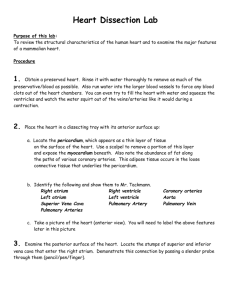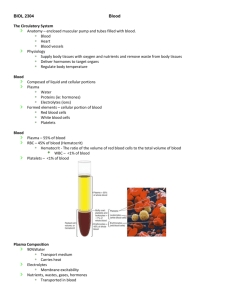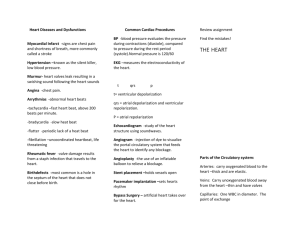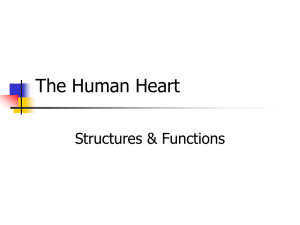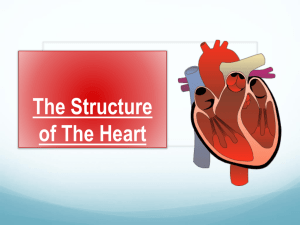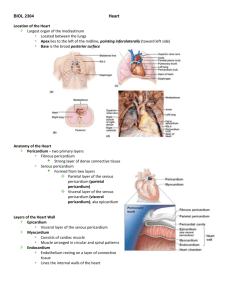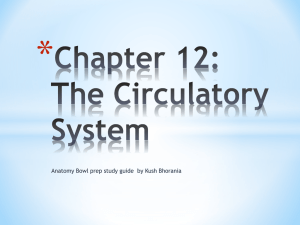Dissection of a Pig Heart
advertisement
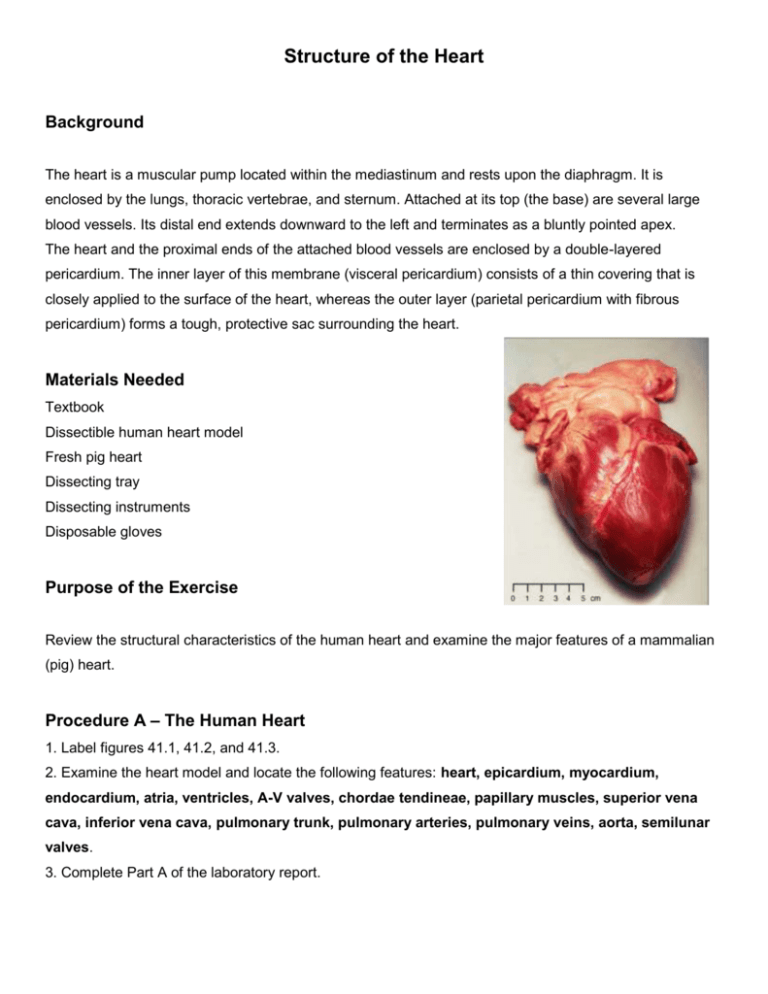
Structure of the Heart Background The heart is a muscular pump located within the mediastinum and rests upon the diaphragm. It is enclosed by the lungs, thoracic vertebrae, and sternum. Attached at its top (the base) are several large blood vessels. Its distal end extends downward to the left and terminates as a bluntly pointed apex. The heart and the proximal ends of the attached blood vessels are enclosed by a double-layered pericardium. The inner layer of this membrane (visceral pericardium) consists of a thin covering that is closely applied to the surface of the heart, whereas the outer layer (parietal pericardium with fibrous pericardium) forms a tough, protective sac surrounding the heart. Materials Needed Textbook Dissectible human heart model Fresh pig heart Dissecting tray Dissecting instruments Disposable gloves Purpose of the Exercise Review the structural characteristics of the human heart and examine the major features of a mammalian (pig) heart. Procedure A – The Human Heart 1. Label figures 41.1, 41.2, and 41.3. 2. Examine the heart model and locate the following features: heart, epicardium, myocardium, endocardium, atria, ventricles, A-V valves, chordae tendineae, papillary muscles, superior vena cava, inferior vena cava, pulmonary trunk, pulmonary arteries, pulmonary veins, aorta, semilunar valves. 3. Complete Part A of the laboratory report. Figure 41.1 Label this anterior view of the human heart. Figure 41.2 Label this posterior view of the human heart. Figure 41.3 Label this anterior view of a coronal section of the human heart. Procedure B – Dissection of a Pig Heart 1. Obtain a fresh pig heart. Rinse the heart in water and also run water into the large blood vessels to force any blood clots out of the heart chambers. 2. Place the heart in a dissecting tray with its ventral surface up. Proceed as follows: a. Although the relatively thick pericardial sac probably is missing, look for traces of this membrane around the origins of the large blood vessels. b. Locate the visceral pericardium, which appears as a thin, transparent layer on the surface of the heart. Use a scalpel to remove a portion of this layer and expose the myocardium beneath. Also note the abundance of fat along the paths of various blood vessels. This adipose tissue occurs in the loose connective tissue that underlies the visceral pericardium. c. Identify the following: right atrium, right ventricle, left atrium, left ventricle, right auricle, left auricle, atrioventricular sulcus, anterior interventricular sulcus. d. Carefully remove the fat from the anterior interventricular sulcus, and expose the blood vessels that pass along this groove. They include a branch of the left coronary artery (anterior interventricular artery) and a cardiac vein. 3. Examine the dorsal surface of the heart and proceed as follows: a. Identify the atrioventricular sulcus and the posterior interventricular sulcus. b. Locate the stumps of two relatively thin-walled veins that enter the right atrium. Demonstrate this connection by passing a slender probe through them. The upper vessel is the superior vena cava and the lower one is the inferior vena cava. 4. Open the right atrium. To do this, follow these steps: a. Insert a blade of the scissors into the superior vena cava and cut downward through the atrial wall. b. Open the chamber, locate the tricuspid valve (right atrioventricular valve),and examine its cusps. c. Also locate the opening to the coronary sinus between the valve and the inferior vena cava. d. Run some water through the tricuspid valve to fill the chamber of the right ventricle. e. Gently squeeze the ventricles, and watch the cusps of the valve as the water moves up against them. 5. Open the right ventricle as follows: a. Continue cutting downward through the tricuspid valve and the right ventricular wall until you reach the apex of the heart. b. Locate the chordae tendineae and the papillary muscles. c. Find the opening to the pulmonary trunk and use the scissors to cut upward through the wall of the right ventricle. Follow the pulmonary trunk until you have exposed the pulmonary valve. d. Examine the valve and its cusps. 6. Open the left side of the heart. To do this, follow these steps: a. Insert the blade of the scissors through the wall of the left atrium and cut downward to the apex of the heart. b. Open the left atrium and locate the four openings of the pulmonary veins. Pass a slender probe through each opening, and locate the stump of its vessel. c. Examine the bicuspid valve (left atrioventricular valve) and its cusps. d. Also examine the left ventricle and compare the thickness of its wall with that of the right ventricle. 7. Locate the aorta, which leads away from the left ventricle, and proceed as follows: a. Compare the thickness of the aortic wall with that of a pulmonary artery. b. Use scissors to cut along the length of the aorta to expose the aortic valve at its base. c. Examine the cusps of the valve and locate the openings of the coronary arteries just distal to them. 8. As a review, locate and identify the stumps of each of the major blood vessels associated with the heart. 9. Discard the specimen as directed by the instructor. 10. Complete Part B of the laboratory report. Part A Match the terms in column B with the descriptions in column A. Place the letter of your choice in the space provided. Column A Column B ___ 1. Upper chamber of the heart a. Aorta ___ 2. Structure from which chordae tendineae b. Atrioventricular sulcus originate c. Atrium ___ 3. Prevents blood movement from right ventricle to right atrium d. Cardiac vein ___ 4. Membranes around the heart e. Coronary artery ___ 5. Groove separating left and right ventricles f. Coronary sinus ___ 6. Prevents blood movement from left g. Endocardium ventricle to left atrium h. Interventricular sulcus ___ 7. Gives rise to left and right pulmonary arteries i. Mitral (bicuspid) valve ___ 8. Drains blood from myocardium into right j. Myocardium atrium k. Papillary muscle ___ 9. Inner lining of heart chamber l. Pericardial cavity ___ 10. Layer largely composed of cardiac muscle tissue m. Pericardial sac ___ 11. Space containing serous fluid to reduce n. Pulmonary trunk friction during heartbeats o. Tricuspid valve ___ 12. Drains blood from myocardial capillaries ___ 13. Supplies blood to heart muscle ___ 14. Distributes blood to body organs (systemic circuit) except lungs ___ 15. Groove separating atrial and ventricular portions of the heart Part B Complete the following: 1. Compare the structure of the tricuspid valve with that of the pulmonary valve. 2. Describe the action of the tricuspid valve when you squeezed the water-filled right ventricle. 3. Describe the function of the chordae tendineae and the papillary muscles. 4. What is the significance of the difference in thickness between the wall of the aorta and the wall of the pulmonary trunk? 5. List in order the major blood vessels, chambers, and valves through which blood must pass in traveling from a vena cava to the aorta. Critical Thinking Application What is the significance of the difference in thickness of the ventricular walls

